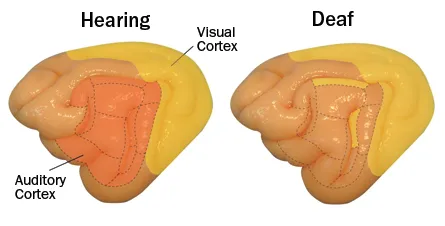How being deaf can enhance sight
Hearing-specialized brain regions adapt to visual input
- More than 2 years ago
Some deaf people have extraordinarily keen vision, and a new study of cats may explain why. The results, published online October 12 in Nature Neuroscience, show how parts of the brain normally dedicated to a sense that has been lost can pitch in to augment another type of input.
For years, researchers have known that deaf people often have superior peripheral vision and motion detection, but just how the brain creates these advantages was unclear. “Over the years, we’ve speculated about how these changes might be taking place,” says neuroscientist Helen Neville of the University of Oregon in Eugene, but a clear cause has been elusive.
In the new study, researchers led by Stephen Lomber found that in deaf cats, brain regions important for hearing get co-opted to enhance vision. Instead of processing sound, these regions lend a hand to the visual system. For the first time, the study establishes a causal link between particular auditory regions and vision enhancements.
“There have been all these theories out there for what region of the brain might be responsible for this, but no one has actually gone in there and demonstrated it,” Lomber says. Since cat brains are organized much like human brains, the results may mirror what happens in the brain of a deaf person.
Deaf cats don’t have better overall vision than their hearing counterparts, the researchers found. Rather, like deaf humans, the cats are better at two particular visual tasks — seeing objects in far peripheral vision and detecting very slow motion. These particular enhancements might help deaf people assess their surroundings more accurately: “You can’t hear the dog running or the car coming at you, so being able to see it seems like a really good skill,” says Lomber, of the University of Western Ontario in London, Canada.
After establishing that these two visual abilities were enhanced in deaf cats, Lomber and his team tested whether hearing-related brain areas were responsible for the boost. With the help of a 3-millimeter-wide cooling device, the researchers inactivated very particular regions of the cats’ auditory cortices. The coil sits on the outside of the brain and induces a precisely localized hypothermia, causing the region to effectively shut down until the device is turned off.
Deaf cats with chilled hearing-related brain regions lost their visual edge, and in a very specific way. “What we found was, much to our surprise, that these functions were not distributed randomly over the auditory cortex, but they were specifically localized in particular places,” Lomber says. For instance, when a brain region that is normally important for localizing auditory signals was shut off, the deaf cats lost their superior ability to spot a laser that flashed in the far periphery of their visual fields, the team found. “It seems that if there’s no auditory stimulation, the auditory cortex was still doing what it would normally do, but with a different sensory input — in this case, vision,” Lomber says.
Since the cats were deaf from birth, the study can’t determine how malleable these brain regions are over the course of development. Brain cells in auditory regions may lose the ability to change their allegiance and lend a hand with vision if the onset of deafness is too late in life, Neville says.
More studies are needed to determine whether this type of sensory mingling applies to other systems in the brain, says neuroscientist Brigitte Röder of the University of Hamburg. “We need to see whether this is a general effect,” she says. Specific visual system regions might be lending a hand to boost hearing performance in blind people, for instance.








